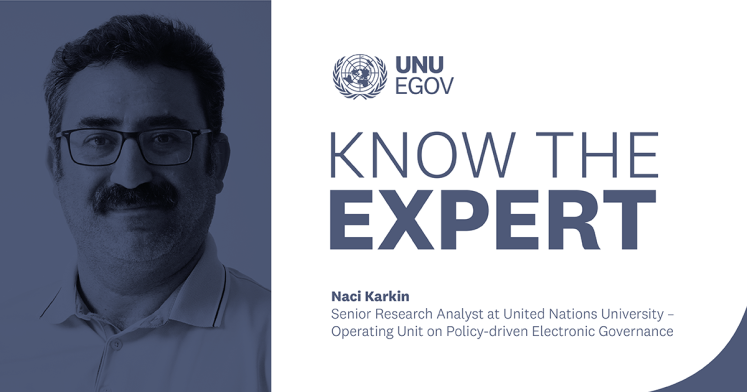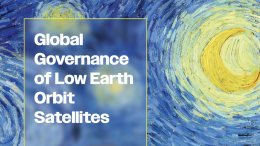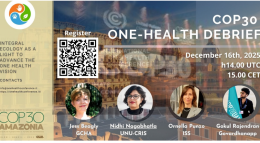After more than two decades in academia, Naci Karkin wanted to work on projects with tangible impact on society, and found that opportunity at UNU-EGOV, where he has worked since 2022.
His career spans public administration, local governance, and e-participation, always driven by the belief that research should serve the public good.
In this interview, Karkin reflects on his journey from theory to practice, leading projects that strengthen transparency, participation, and trust in government. He highlights the importance of interdisciplinary collaboration and the ethical responsibility of researchers to remain persistent and independent, and to have the courage to “speak truth to power”, even when it is uncomfortable.
Naci Karkin holds a PhD in Public Administration and has over 20 years of academic experience in public sector innovation, local governance, and e-participation. Before joining UNU-EGOV in 2022, he served as a professor and researcher in Türkiye and as a Visiting Fellow at Delft University of Technology (TU Delft) in the Netherlands.
United Nations University (UNU-EGOV): What first inspired you to explore the intersection of public administration and digital governance?
Naci Karkin (NK): The first time I noticed the intersection of public administration and digital governance dates back to the times I needed to select a relevant and timely topic for my Master's thesis. After the millennium, as was known, e-government issues were on the agenda of many countries, thus there were many related issues. However, I noticed that there is a gap in the intersection of digitalization and public administration in the context of local governments, since the local governments were disadvantaged compared to central government agencies in terms of their financial, organizational, and managerial shortcomings and technical incapacity concerning budget, human resources, and organizational setup. Therefore, I decided to focus on the attitudes and behaviours of local elected officials towards e-municipality services. After completing the thesis, I noticed that although central governments tried to support the development of local governments in their efforts to catch up with the respective digitalization, they far lagged behind. Then, I changed my focus to a different issue, again at the local level, but a totally different issue, the localization of public services, particularly local provision of health services, which were on the national agenda of the government at that time. After obtaining the PhD. degree, I decided to get back to digital government issues again. Thus, I have been trying to have expertise uninterruptedly on the intersection of public administration and digital governance since 2012.
UNU-EGOV: After more than 20 years in academia, how has the shift to UNU-EGOV and international projects changed your perspective?
NK: After having a long tenure in academia, I was feeling the need to fill in a gap by actively involving myself in projects (research or development, but having implications for actual implementation). I was a postdoc and then a visiting fellow at TUDelft in the Netherlands, which was my first academic sabbatical leave from my home. During my days at TBM of TUDelft, I have been nurtured by my supervisor, Prof. Dr. Ir. Marijn Janssen, and all other colleagues there in terms of theory and research. After getting back to my land in 2016, I felt the need to actively participate in projects since I had no experience in conducting any projects whose outputs and outcomes were beneficial for society at large. So, I was in search for some time before being drafted by the UNU-EGOV.
When I was drafted as a senior research associate by the Unit in 2022, I was assumed to be a part of the team that was formed to run a project for setting up a framework and respective mechanisms concerning e-participation and governance based on beneficiary feedback. The project was an integrated one, having two separate but interrelated legs. One project was on developing a governance framework for overseeing the work of government agencies and supportive organizations in responding to beneficiary feedback. The other project was on developing standards and guidance manuals for response by government agencies to beneficiary feedback. More information can be found on the UNU-EGOV website.
The first feeling of mine was getting a little frustrated as this was a pass from delivering theoretical and conceptual information to actual realization of a project. During my tenure in academia, I have assumed both delivering lectures and participating in some projects, but even the nature of these projects was mainly academic. Thus, when I was a member of the Unit and the team, I had no solid experience of running a development project, including both designing infrastructure and implementation dimensions. After meeting with the team members and strong support from my supervisors and colleagues, the frustration was gone, and we made progress day by day. The project lasted more or less two years, and at the end, we were able to finish and deliver the whole framework to the client.
The main feeling of mine after the successful completion was to have success, cooperation, and collaboration with my team members who had different backgrounds, in terms of education and practice, I mean. I had the opportunity with colleagues who had mainly engineering, but also with architecture, communication sciences, law, information sciences, and business administration. This opportunity seems a unique opportunity to collaborate with different people with different backgrounds for the same aim. This opportunity would rarely come if I were in academia all alone.
UNU-EGOV: In your view, what are the biggest challenges to ensuring that digital participation is truly inclusive?
NK: Taking the participation, having many synonyms with slightly different meanings like engagement or involvement, as a process, I see many barriers, difficulties, hurdles or challenges in general with many catalyzers and facilitators for the opportunities or benefits to embrace. The most important or the foremost is the perceptions, I guess. How the government sees the stakeholders, including citizens, and how the citizens or stakeholders in general see the government. Does the government place itself as a differentiated actor in designing the public policies or providing the public services, or does it see itself as the protector of the public interest? I mean, we need to understand whether and how the government sees itself as a differentiated actor with differentiated interests different than those of the public, or it pursues the interests of the public. Here we also see an important issue. Neither the government nor the public is an anonymous entity; rather, they comprise people from different backgrounds with differentiated aims and interests to pursue. The main thing we disregard is to accept the government or the public as a single, unified entity with the same or similar aims or interests. Thus, I need to raise this issue as the most important parameter to evaluate in the equation, if the participation is a process to handle.
Another important issue is how to reach a collective when dealing with different people, differentiated aims, or differentiated interests, given either by the government or the public. As I argue, when we talk about the government, we usually have an inclination of great power with a great background, like the Leviathan in the past. I do not think so, I think the government is represented by the head of state or government and includes thousands of public employees, if not millions. Thus, for the government to conduct its duties and responsibilities, all the constituent parts should behave in harmony, but for a disaster or nonfunctionality, one part is enough to prevent it from functioning. For example, all the public relations could get deterred if a public employee behaves beyond his/her limits or if she/he behave as if it is his or her own but not a public role.
After dealing with the essence of the issue, we can have many papers in the literature or many official documents from governmental agencies, non-governmental agencies, or international agencies that focus on the meaningful inclusion of all the parties interested. It is an issue of essence, I mean, not the issue of methodology. The methodology will be apparent and smooth if the essential issues are aware.
UNU-EGOV: Could you share one project or initiative that you found particularly impactful for citizens or governments?
NK: I can give the ePART4GOV project as a good example. As I previously mentioned, there is related information on our Unit’s website (https://unu.edu/egov/project/epart4gov-integrated-project-framework-e-participation-and-governance-mechanisms-0). In any case, I can give a brief overview of the project I had the honour to manage.
In this integrated project (Project A and B), the design of a governance mechanism required by public institutions for stakeholder participation and a functional mechanism necessary for the e-participation process was proposed. Therefore, this integrated project aimed to design two interrelated projects as a single project and subsequently implement them in a specific country. Consequently, within the context of the project, a governance framework with a theoretical basis and an associated operational e-participation mechanism were proposed to the client. Of course, the standards, guidelines, and implementation documents necessary for the operation of this process have also been prepared and delivered, and the project's implementation process (to provide any necessary technical and other support) is expected.
First, two deliveries of Project B, which are fundamental, interrelated, but independent of each other, as specified in the contract, were completed in 2023. As seen in the updated project calendar, within the scope of Project B, a situation analysis covering 5 countries was completed. In addition, country case analysis and the existing legal and administrative regulations on the subject were examined, and a needs analysis was presented. Both deliveries were completed, presented to the recipient, and accepted by the client in December 2023.
Regarding Project A, as with Project B, the case study covering five countries has been completed, and the country case study has also been finalized and communicated to the relevant party. These two deliverables within the context of Project A have been approved by the client. Following the comparative analysis of the sample countries and the country case studies, the theoretical framework of the application model covering e-participation processes has been completed, and the final version of the model prior to the pilot phase has been delivered. Following the completion of the pilot phase, the final version of the model has been presented based on the data and feedback obtained, and the model is to be implemented nationwide. Furthermore, the necessary specifications and implementation guidelines for standardizing the application have been prepared and delivered.
United Nations University (UNU-EGOV): You have published extensively on digital government and citizen engagement. From your perspective, what are the main challenges researchers face when trying to publish in this field? And what makes a paper stand out in this domain?
NK: It is a good question indeed. As I mentioned, I have been trying to have expertise on the intersection of public administration and digital governance, with a specific focus on the interaction between government and stakeholders, for more than 15 years. As a fellow and as an experienced student of the field, I have experienced many hurdles in pursuing a career in this so-called expertise. The first one I remember is to get data from government officials. Without the data from the field, you are assumed to study at a desk, which would inevitably lag you behind, since all the prestigious outlets would be more interested in empirical papers or papers aiming to contribute to the theories of the discipline. Of course, conceptual or exploratory papers have the chance to get published, but with a significant decrease in numbers when compared to papers with data.
Concerning the data to be obtained from the government or from the field in general, you need to secure funds, which would require many obstacles. I am not saying it is impossible, but it is so difficult to secure since everyone asks for “experience”, no one tells how to acquire “experience”.
A paper, if published by top-rated outlets or prestigious publishers, will endure and be more visible to the entire audience when compared to other papers, and thus will be more recognized by peers and more cited. There are some instances that you cannot explain by reason that a paper gets endorsed even though it does not bear the qualifications I have argued, but the main path seems to be what I have tried to draw.
United Nations University (UNU-EGOV): Finally, what advice would you give to young researchers interested in public sector innovation?
NK: My main advice would be pursuing a career in academia or a career in research and publication, which necessarily requires more devotion and sacrifice when compared to other career paths. If you are not ready to be a student for life, then it will be hard to handle the obstacles and difficulties ahead. I remember myself in my undergraduate education, delivering lectures, hypothetically, after all the people, including my peers, had left the auditorium. Before all those, I would recommend checking yourself if you like to read and to explain what you have learnt with your own capacity, as the researcher also means to speak up, not just delivering the lectures to peers. Speaking up, which also means telling the truth to the power, requires being independent and impartial, particularly for social sciences. You need to be ready with the truth based on data or information, even though you feel it is convenient to tell, despite many reservations.
Suggested citation: "Know the Expert "Naci Karkin" - October," United Nations University, UNU-EGOV, 2025-10-24, https://unu.edu/egov/article/know-expert-naci-karkin-october.





